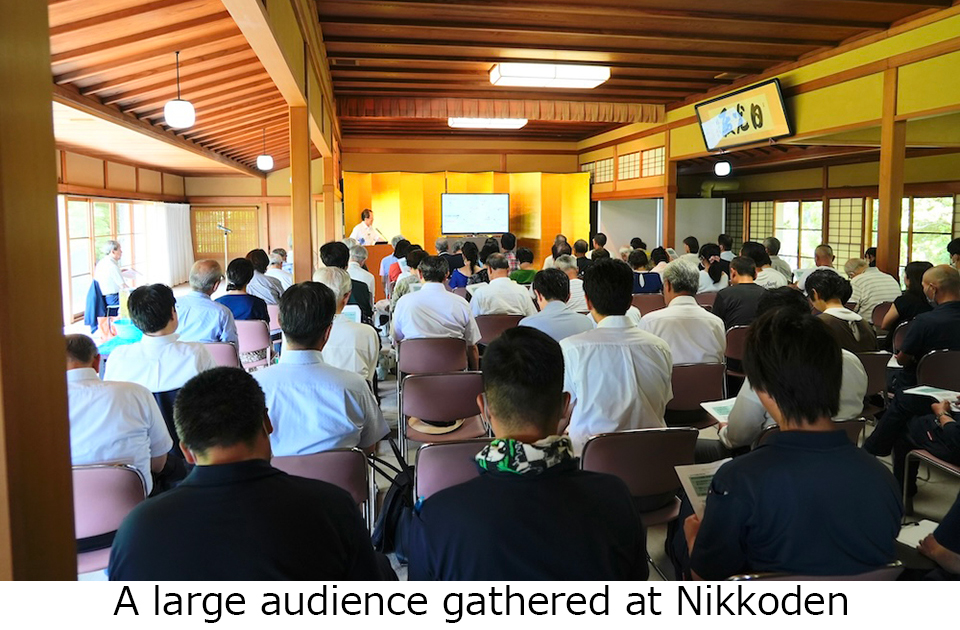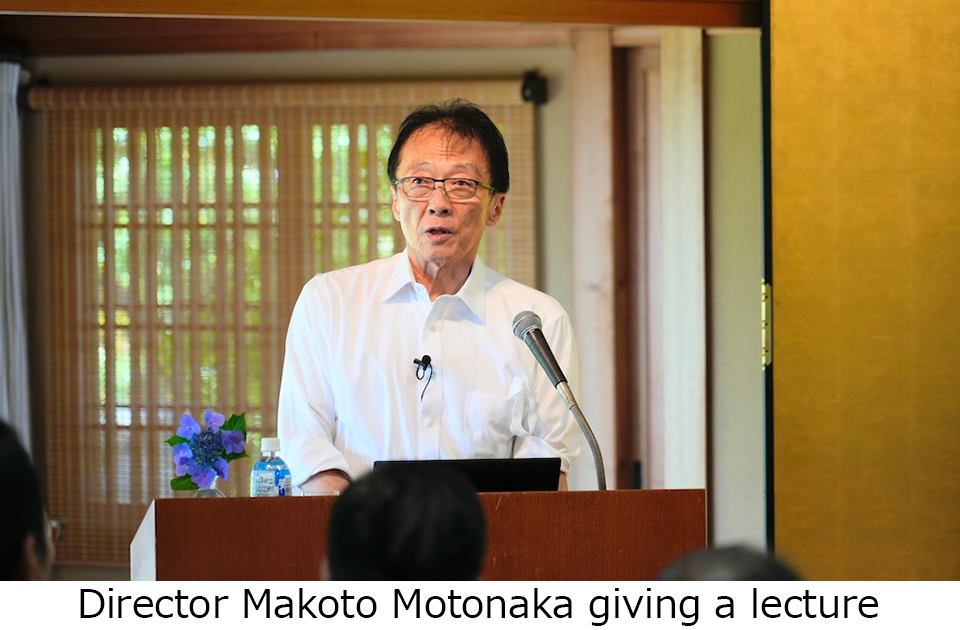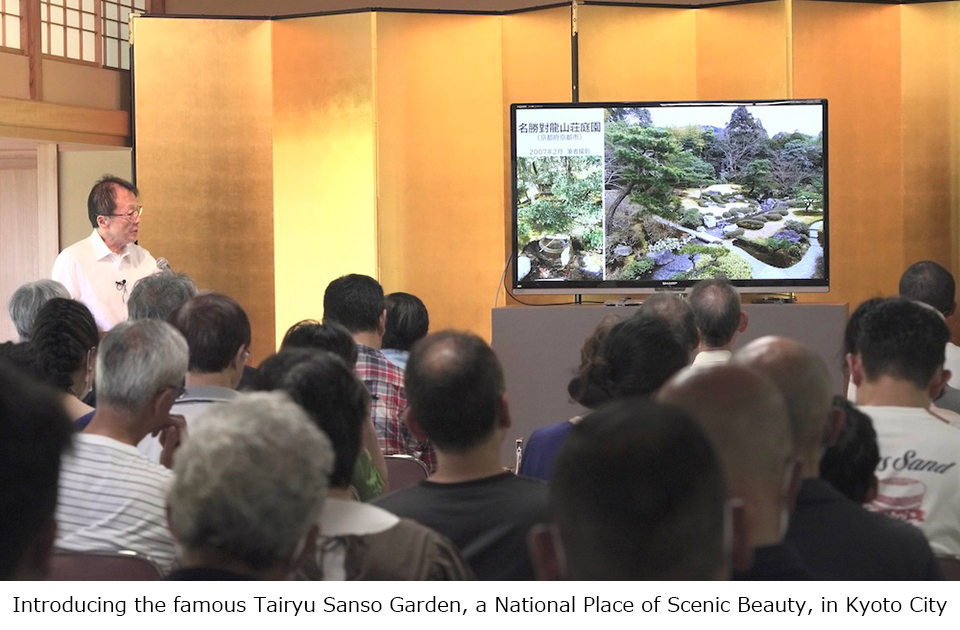Tags:Art and LifeKanto
Hakone Town, Kanagawa Prefecture
Director Makoto Motonaka talks about the essence of Shinsenkyô
The 2nd Shinsenkyô Garden Seminar was held on July 20, 2024 at Nikkoden in Shinsenkyô, a National Place of Scenic Beauty, in Gora, Hakone. Makoto Motonaka, Director of the Nara National Research Institute for Cultural Properties, a leading researcher of Japanese cultural properties and landscapes and a member of the Shinsenkyô Preservation and Utilization Committee, gave a lecture on the subject of “Modern and Contemporary Japanese Gardens and Shinsenkyô.” More than 150 people with an interest in Shinsenkyô and Japanese gardens gathered at the venue.

Director Motonaka introduced that based on the “Research Report on Modern Gardens, Parks, etc.” compiled by the Agency for Cultural Affairs, the characteristics of modern Japanese gardens. They are classified into 10 categories, such as “Gardens of Artists, Scholars, etc.” or “Gardens of the Imperial Household.” He also introduced three perspectives for evaluating the garden’s characteristics: 1. “It retains the original components and shows the important changes that took place after the garden was created,” 2. “It represents the characteristics of its time in the history of gardens and related materials have been preserved,” and 3. “It shows characteristics from the perspective of the region.”

He shared specific examples of modern gardens, including the Heian Shrine Gardens, Murian Garden and the Tairyu Sanso Garden, all located in the Okazaki-Nanzenji area of Kyoto City and were designed by Ogawa Jihei VII, a representative landscape gardener of the Meiji period. Common features of the two gardens are that they use Higashiyama as a backdrop and the Lake Biwa Canal, an artificial waterway, to create waterfalls and ponds.
Next, he introduced four National Places of Scenic Beauty—Kiyotaka Shoin Garden Teien, Kanehiranari-en, Zuiraku-en, and Seibi-en—which are gardens based on the Oishi Bugaku style of garden that spread mainly in the Tsugaru region of Aomori Prefecture from the end of the Edo period to the early Showa period. In addition, the program featured two National Places of Scenic Beauty—Tofuku-ji Temple Honbo Garden in Kyoto City, Kyoto Prefecture, and the Kishiwada Castle Garden (Hachijin Garden) in Kishiwada City, Osaka Prefecture—both created by Shigemori Mirei, a landscape gardener active from the modern era to the present day, as well as introducing a number of other modern and contemporary gardens.

At the conclusion of his lecture, he mentioned Shinsenkyô. He confirmed that Shinsenkyô makes the most of the unique location of Gora, Hakone, and is characterized by a unique landscape composition, with a variety of scenery to be seen at every turn along the garden paths that crisscross the land. Furthermore, in light of the Agency for Cultural Affairs’ aforementioned classification of gardens, because it is the work of the cultural figure, Mokichi Okada, it falls into the category of “Gardens of artists, scholars, etc.”; and because the Hakone Museum of Art is present there, it falls into the category of “Gardens of public facilities, schools, companies, factories, etc.”
From an evaluation standpoint, the judges stated that the garden met three criteria: 1. “The original components of the garden, such as the topography, scenery, and buildings, have been kept intact and are being reproduced exactly as documented, indicating the process of important changes,” 2. “The garden captures a large view of the scenery outside, and features grass-covered slopes and plazas, expressing the characteristics of the era common to modern and contemporary gardens,” and 3. “The volcanic topography unique to Hakone has been made full use of, expressing characteristics from the perspective of the region.”
Finally, he emphasized that the essence of Shinsenkyô lies in Okada’s wish to create an “open garden” like a park where everyone could feel happy, and that this is reflected everywhere in Shinsenkyô. He said “it is important that Shinsenkyô carry out activities to ensure that Okada’s feelings are properly conveyed to visitors and understood.” To conclude his lecture, he expressed his hope that understanding will spread not only to those involved in the management of Shinsenkyô, but also to those involved in urban development throughout the region, and that the true essence of Shinsenkyô will be conveyed to visitors.
Impressed by Director Motonaka’s powerful appeal, some in the audience said things like, “I want to think about what I can do to help more people know about Shinsenkyô and understand its true essence.”
The next seminar will be held on October 12, 2024 and will feature a lecture by Seizo Uchida, a specially appointed professor at Kanagawa University and a researcher in the history of modern Japanese architecture and housing, and a member of the committee for the preservation and utilization of “Shinsenkyô,” a National Place of Scenic Beauty.
Organized by the Executive Committee for Utilizing the Scenic Beauty of Shinsenkyô, co-organized by the Hakone Museum of Art, and supported by the Hakone Town Board of Education






